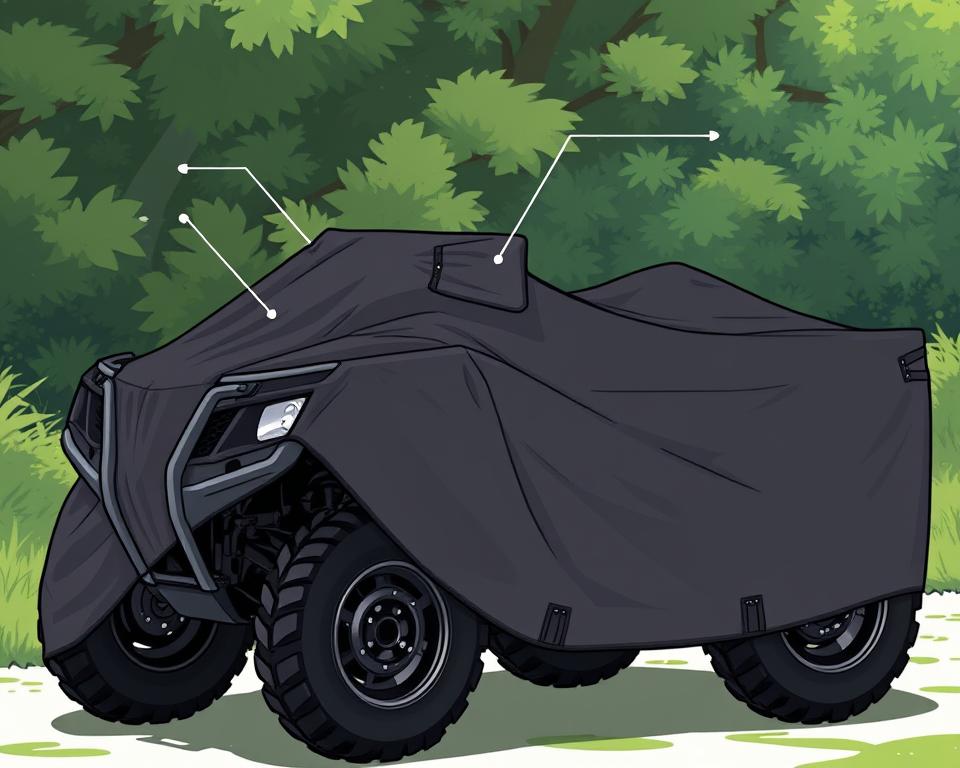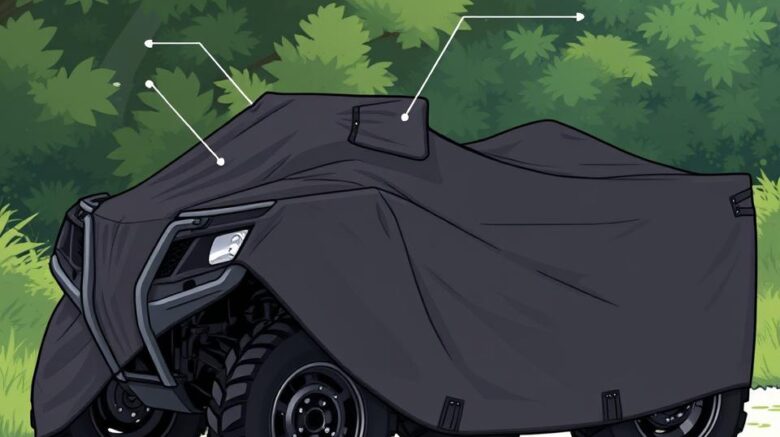Essential ATV Off-Road Checklist for Safe Riding
Surprisingly nearly around 450,000 ATV-related injuries are treated in U.S. emergency rooms each year? This alarming figure highlights the need for safety and preparedness in off-road adventures. Here’s your go-to ATV Off-Road Checklist for maximum safety and enjoyment. Whether you’re tackling rocks or dunes, it’s all included. With the right safety gear and Can Am sound roof essentials, you can minimize risks and boost your adventure.
Notable Observations
- Use this checklist first to prep safely and thoroughly.
- An ATV safety gear checklist is vital for protecting yourself during off-road rides.
- Maintenance matters: check often, ride better.
- Stay fueled and hydrated for peak performance.
- Learn to use navigation tools to avoid getting lost on off-road routes.
- Weather can flip fast—be ready with proper gear.
- Always carry essential tools and recovery kits for on-trail repairs and emergencies.
Understanding the Importance of Safety Gear
Off-road adventures require a strong focus on safety. Riding an ATV is thrilling but comes with risks. Safety gear is essential for protecting riders from accidents and injuries. Gear up correctly with this ATV safety gear checklist.

Essential Protective Gear
Maximizing protection involves several key items:
- Helmets: Choose DOT-approved helmets to prevent head injuries.
- Goggles: Protect your vision with wraparound goggles.
- Riding Gloves: Wear durable gloves for better grip and hand protection.
- Footwear: High boots shield your feet and ankles.
- Body Armor: Chest and back armor add vital protection.
- Neck Protection: Support your neck to prevent serious injury.
Emergency Preparedness
Being ready for emergencies is critical. A well-packed kit might save your life. Key items to include are:
- First aid kit
- Multi-tool
- Tire repair kits
- Portable air compressors
- Emergency blankets
- Whistles
- Matches
ATV Equipment for Optimal Performance
Gear choices affect how well your ATV runs. Knowing the must-have ATV equipment ensures you’re ready for any journey. Routine checks keep your ATV working its best.
Must-Have ATV Equipment
- Durable Tires: Invest in tires designed for various terrains to improve traction and handling.
- Cargo Systems: Keep tools and spares within reach.
- Fuel Reservoir: Never run low—use a proven fuel tank.
- First Aid Kit: Stock your kit with bandages, antiseptic, and meds.
Regular Maintenance for Longevity
A maintenance schedule is your ATV’s best friend. Regular inspections should encompass:
- Checking air filters to keep the engine running smoothly.
- Grease your chain often to avoid skip and wear.
- Inspecting brakes for safety before each ride.
Stay on top of upkeep and your ATV will perform its best.
The Essential ATV Off-Road Checklist
Don’t skip your pre-ride safety scan. An effective ATV maintenance checklist ensures your vehicle’s safety and performance. Each pre-ride inspection step requires attention to detail. A little prep goes a long way.
Pre-Ride Inspection Basics
Your pre-ride look-over sets the tone for safety. This quick evaluation helps riders identify and address issues before they start. Key elements to check include:
- Tire pressure and tread condition
- Fluid levels such as oil and fuel
- Brakes and controls functionality
- Operational lights and horn
- Chain or driveshaft integrity
T-CLOC Inspection Method
T-CLOC covers every critical system. It covers Tires and Wheels, Controls, Lights, Oil and Fuel, and Chain/Driveshaft. This method ensures all critical areas are covered:
| Inspection Area | Checklist Items |
|---|---|
| Tires and Wheels | Check tire pressure, inspect tread depth, look for damage |
| Controls | Test brakes, throttle, and clutch for smooth operation |
| Lights | Ensure headlights, brake lights, and indicators are functioning |
| Oil and Fuel | Check oil level, inspect for leaks, and fill fuel tank |
| Chain/Driveshaft | Examine for wear, proper tension, and lubrication |
Spending a few minutes on this ATV maintenance checklist can make rides safer and more enjoyable. Prevent roadside repairs with a fast check.
Hydration and Nutrition for Long Rides
Don’t underestimate water and snacks on extended outings. Always carry more water than you think you’ll need. Water packs help maintain endurance and alertness. Pack high-energy bites to keep you going.
Importance of Staying Hydrated
Drink often—don’t wait for thirst. It’s important to drink water consistently, not just when thirsty. Backpack reservoirs keep water flowing hands-free.
High-Energy Snacks to Pack
Good snacks keep you sharp and energized. Pack portable, long-shelf treats. Some ideal choices include:
- Protein bars
- Nut mixes
- Dried fruits
- Beef jerky
These snacks provide a quick energy boost without hindering the riding experience. Variety prevents taste fatigue and keeps you powered.
Navigation Tools for Off-Roading Adventures
Stay on course with proven navigation aids. A dependable nav setup means you’ll always find your way.
Advanced GPS Systems
An advanced GPS system is a must for off-road adventures. Choose units with rugged builds, offline charts, and extended runtime. Brands like Garmin and TomTom offer models designed for off-road use, ensuring durability and precision.
Traditional Navigation Aids
Always carry a paper map along with your GPS. Waterproof maps and compasses are vital backups when your GPS fails. Wind your own way with map and compass skills. Tech plus tools equals total navigation readiness.
Communication Equipment for Safety
When phones fail, two-way radios deliver. Communication gear is as critical as your helmet. Knowing you can call for help reduces stress.
Don’t split up without radios in hand. Opt for radios rated for miles of reach. They allow for real-time updates on any changes or hazards. When choosing two-way radios, look for models with:
- Weatherproof construction to resist the elements
- Extended run-time for extended trips without needing a recharge
- Channel selection for clear communication without interference
No ride is complete without radios. Group comms save time and reduce risk. When reception is zero, your radio still works. With the right tools, your off-road trips will be smoother and more enjoyable.
Self-Rescue Gear for ATV Riders
Don’t be caught unprepared—pack rescue gear. Relying on yourself starts with proper rescue tools. Prepared riders make safer group members.
Winches and Recovery Kits
Never ride dirty trails without a winch. A winch paired with a detailed ATV recovery kit is even more effective. Recovery kits usually include:
- Tow straps
- D-rings
- Recovery boards
- Gloves
Practice recovery techniques before you need them. With quality ATV recovery kits, you can overcome mud, rocks, or other obstacles and continue your journey.
Trail Recovery Essentials
Pack these extras along with your winch. These include:
| Equipment | Purpose |
|---|---|
| Recovery Straps | Used for towing or pulling ATVs out of tight situations. |
| Shovel | Helps clear obstacles and dig out vehicles when stuck. |
| Traction Mats | Provides grip under tires in muddy or slick conditions. |
| Portable Air Compressor | Enables quick tire inflation after deflating for better traction. |
Don’t rely on luck—bring the right tools. Skills plus gear equal top-tier off-road safety.
Staying Adaptable: Preparing for Weather Changes
Weather variability is a major challenge in off-roading. It’s vital to be ready for sudden changes to stay safe and enjoy the ride. Don’t forget your layers and rain shell.
Layering your clothes is key to adapting to temperature changes. Start with wick-away fabrics. Mid-layers trap heat and pack small. Lastly, have a waterproof and wind-resistant outer shell. Stay dry and warm through all conditions.
Weather-Appropriate Clothing
- Rain Shells: Stay dry when the sky opens up.
- Breathable Pants: Stay cool and dry with breathable pants.
- UV Gear: Lightweight, long-sleeved shirts and wide-brimmed hats safeguard against harmful UV rays.
- Cold-Weather Gloves: Warm gloves maintain dexterity in chill.
Gear up for every climate challenge. Comfortable riders ride longer and safer.
Tools for On-Trail Repairs
Essential repair tools are a rider’s best friend. Pack tools you trust. Tackle trailside trouble with confidence.
Must-Have Tools and Kits
No ride is complete without a toolkit. Pack only the essentials—no junk. Critical ATV repair tools might include:
- Tire irons for changing flat tires
- Pliers for gripping and cutting
- Wrenches for various sizes of bolts and nuts
- A multi-tool for versatility
- Spare items such as spark plugs and electrical wire
- Duct tape for quick fixes
Tools at hand mean no surprises.
Basic Emergency Supplies
In addition to essential tools, packing basic emergency supplies for ATV is vital. These supplies help ensure your safety in challenging situations:
- First aid kit for injuries
- Flashlight with extra batteries for night-time visibility
- Emergency whistle for signaling assistance
- Reflective triangles or flares to warn other riders
- Water and high-energy snacks for sustenance
Be ready for the unexpected. Your safety net on the trail.
In Summary
Preparation is the secret to epic trails. Using the Essential ATV off-road checklist and acquiring gear from trusted sources is key. Ride confidently on every surface.
With the right protective gear, navigation tools, and communication equipment, you’re set for safe riding. Prep wisely for peak thrills and protection. Embrace excitement, ditch the doubts.
Stay ready, ride with care, and enjoy the unforgettable moments off-roading offers. Every leg of the trip matters. Use this guide for the best off-road experiences.
Frequently Asked Questions
What should I include in my ATV safety gear checklist?
Start with a DOT helmet and sturdy goggles. Add gloves, boots, and torso protection. Consider a neck brace for extra safety. Remember to pack an emergency kit with a first aid kit and multi-tools for preparedness.
How can I ensure my ATV is well-maintained?
Inspect air filters and grease the chain often. Inspect brakes as well. Regular service keeps your ATV trail-ready.
What does the T-CLOC inspection method entail?
T-CLOC is a five-step pre-ride routine. Cover Tires, Controls, Lights, Oil/Fuel, Chain in T-CLOC. T-CLOC confirms all systems go for trail use.
How to gauge water needs off-road?
Overestimate your water needs. Accurately estimating hydration needs prevents fatigue, which is critical during long rides. Use a hydration bladder for quick sips.
What should I bring for navigation during my off-road adventure?
Use an off-road GPS unit. Also carry a compass and laminated maps.
Why carry two-way radios?
Effective communication is vital for safety and reassurance during off-road adventures. In no-signal zones, radios shine.
Must-have self-rescue tools?
Every ATV rider should carry a winch and a detailed recovery kit. Include straps, shackles, and traction boards.
How can I prepare for sudden weather changes while off-roading?
To prepare for sudden weather changes, wear layered clothing that can be adjusted as temperatures change. Don’t get caught soaked—bring waterproofs. Wear sun-blocking fabrics and hats.
What tools should I pack for on-trail repairs?
Carry essential wrenches, pliers, and irons. Have spares and tape for quick fixes.
